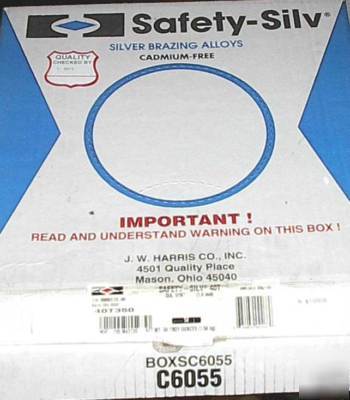Reduce Scrapping and Smelting, Promote Component Reuse > Electric Powered
> Metalworking
> Machining Centers
> Manual
> Silver brazing solder safety-silv 40T 40% 5 troy oz.
Silver brazing solder safety-silv 40T 40% 5 troy oz.
This listing is for FIVE (5) troy ounces of J.W. Harris Safety-Silv 40T silver brazing/soldering alloy wire.
This alloy has very good workability and a rather wide range of softening/melting temperatures (1220 F- 1310 F). Can fill gaps and produce excellent fillets.
Silver solder is amazingly versatile, and is better than welding for many applications. The best way to use this material is with some sort of mechanical joint, with very little clearance between parts (a few thousandths of an inch - neither a sloppy nor a force fit). The mechanical joint holds the parts together during the brazing process. The solder wicks into the joint by capillary attraction, and will fill the entire joint if properly heated. You can also just lay one part on top of another, and let the solder wick into the lap joint gap between them. Butt joints are possible, but not recommended.
If you have to connect different metals together, like stainless steel and brass, this is the way to go. There is no way to weld steel and brass, for example. But, this silver solder will easily connect the different metals with a permanent, corrosion-resistant joint.
I use a propane and oxygen torch for better heat and mixture control, adjusting it to a neutral or slightly reducing (rich) mixture. An ordinary propane torch works fine; the better-quality plumber's torches get quite hot, especially if you use MAPP gas instead of propane.
Make sure the parts are clean and shiny where you want the solder to flow, flux them and get both parts hot enough to flow the solder (don't just melt the solder with the flame). Avoid overheating the parts. As soon as the solder flows, wave the torch back and forth to maintain temperature without increasing it. If one part is bigger, put the heat there first. If one part is really thin, don't direct the flame there at all - when the solder melts off the bigger part, it will heat the thinner one. Very thin parts are easily overheated and corroded, even with flux, so it's best to practice on some scrap material before brazing the actual parts together. If you apply flux for a few inches on both sides of the brazing zone, your finished part will remain shiny.
You will need to get the proper silver brazing flux from a welding shop. The white flux is for thin parts, or copper, brass, bronze (easy). For thick stainless steel (not so easy), I suggest using the black flux because thick stainless steel parts typically require a longer, more thorough heat soaking before applying the solder. Wear UV-blocking safety glasses, and avoid breathing the flux fumes. Work outside, or use a fan to vent the work area. Clean the flux residue away with hot water and a brush.
What you get is FIVE (5) Troy ounces (not less than 160 grams, via my Ohaus triple-beam scale) cut from a large coil. The solder wire is 1/16" diameter.
